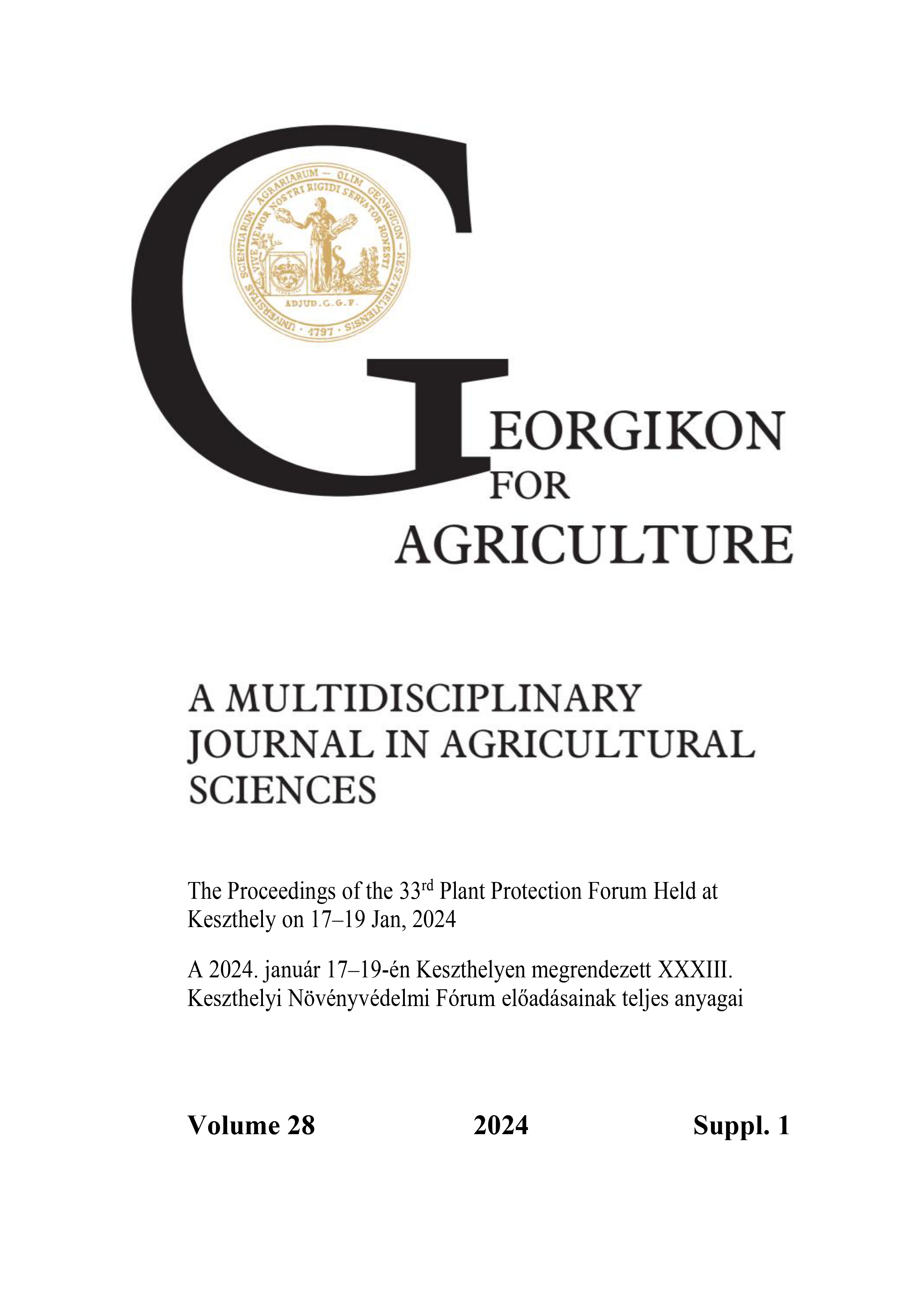Model Study to Investigate the Toxic Interaction between Spirotetramat and Myclobutanil on Pheasant Embryos in the Early Phase of Development
Keywords:
spirotetramat, myclobutanil, interaction, embryonic mortality, pheasant embryoAbstract
The toxic effects of the Movento insecticide (100 g/l (9.29 m/m%) spirotetramat) applied alone or in combination with Systhane 20 EW fungicide (200 g/l myclobutanil (19.4 m/m%) were studied on pheasant embryos, in the early phase of embryonic development. The test materials were injected in 0.1 ml volume into the eggs' air chamber on the first incubation day. Subsequently, on the third day of incubation, permanent preparations were made using the embryos to study the early developmental stage. Embryos fixed on microscope slides and stained with osmium tetroxide solution were studied by light microscopy. The embryonic mortality and the occurrence of developmental anomalies were analysed statistically by the Fisher test. Based on the experiment’s results, the embryonic mortality of pheasant embryos increased in every treated groups (individual or combined administration of the chemicals) compared to the control. The differences in the individually treated groups could not be statistically proven. The simultaneous application of Movento and Systhane 20 EW significantly increased the mortality of pheasant embryos compared to the control. Both test substances were embryotoxic in pheasants, and an additive toxic interaction was revealed between Movento and Systhane 20 EW.
References
Bogenfürst, F. 2004. Handbook of hatching (in Hungarian). Gazda Publishing, Budapest. 42–63.
Budai, P., Fejes, S., Várnagy, L., Szabó, R. and Keserű, M. 2002. Embryonic toxicity of a dimethoate containing insecticide formulation and Cu-sulphate in chicken after individual or combined administration. Communications in Agricultural and Applied Biological Sciences. 67 (2) 99–103.
Clegg, D. J. 1964. The hen egg in toxicity and teratogenicity studies. Fd. Cosmet. Toxicol. 2. 717–718.
Cunningham, W. P. and Woodworth-Saigo, B. 1995. Environmental Science (Dubuque, IA [etc.], Wm. C. Brown Publishers, 1995. 3. ed., 12. chapter).
Faragó, S. 2002. Hunting zoology. Farmer Publishing, Budapest. 496.
Hill, E. F. and Hoffman, D. J. 1984. Avian Models for Toxicity Testing. Journal of the American College of Toxicology. 3 (6) 357–376. https://doi.org/10.3109/10915818409104398
Juhász, É., Szabó, R., Keserű, M., Fejes, S., Budai, P., Kertész, V. and Várnagy, L. 2005. Early embryogenesis study on a dimethoate containing formulation and Cd-sulphate in chicken embryos. Communications in Agricultural and Applied Biological Sciences. 70 (4) 1075–1078.
Juhász, É., Szabó, R., Keserű, M., Budai, P. and Várnagy, L. 2006. Toxicity of a pendimethalin containing herbicide formulation and three heavy metals in chicken embryos. Communications in Agricultural and Applied Biological Sciences. 71 (2 Pt A) 107–110.
Kertész, V. 2001. Effect of heavy metals and PAH derivatives on embryonic development of birds (in Hungarian). Doctoral Thesis (PhD), Szent István University, Gödöllő. 160.
Keserű, M., Budai, P., Várnagy, L., Szabó, R., Juhász, É., Babinszky, G. and Pongrácz, A. 2004. Teratogenicity study of some pesticide in chicken embryos. Communications in Agricultural and Applied Biological Sciences. 69 (4) 803–806.
Lutz, H. 1974. Pesticides and reproduction in homeotherms. Bull. Soc. Zool France. 1 49–50.
Major, L., Budai, P., Lehel, J. and Szabó, R. 2022. Early interaction toxicity study of the pesticides Movento and Topas 100 EC on pheasant embryos (in Hungarian). Georgikon for Agriculture. 26 (1) 190–198.
Maus, C. 2008. Ecotoxicological Profile of the Insecticide Spirotetramat. Bayer Crop Science Journal. 61 (2). 159–180. pp.
Nagy, E. 1984. The pheasant and its hunting. Agricultural Publishing, Budapest. 82–84., 150.
Pan, H. P. and Fouts, J. R. 1978. Drug metabolism in birds. Drug Metab. Rev. 7. 1–253. https://doi.org/10.3109/03602537809108696
Sinkovitsné, H. I. and Benkő, Z. 1993. The effect of organophosphates on the development of the chick embryo (in Hungarian). Állattani közlemények. 79 (1) 95–103.
Szabó, R., Budai, P., Fejes, S., Várnagy, L. and Keserű, M. 2003. Embryonic toxicity of a mancozeb containing fungicide formulation and Cu-sulphate in pheasant after individual or combined administration. Communications in Agricultural and Applied Biological Sciences. 68 (4 Pt B) 803–806.
Szabó, R., Csonka, D., Major, L., Lehel, J. and Budai, P. 2020. Toxicity test of individual and combined toxic effects of glyphosate herbicide and heavy metals on chicken embryos. AGROFOR International Journal. 5 (3) 64–71. https://doi.org/10.7251/AGRENG2003064S
Varga, T., Hlubik, I, Várnagy, L., Budai, P. and Molnár, E. 1999. Embryonic toxicity of insecticide Sumithion 50 EC and herbicide Fusilade S on pheasant after individual or combined administration. Acta Veterinaria Hungarica. 47 (1) 123–128. https://doi.org/10.1556/avet.47.1999.1.13
Várnagy, L., Varga, T., Hlubik, I., Budai, P. and Molnar, E. 1996. Toxicity of the herbicides Flubalex, Fusilade S and Maloran 50 WP to chicken administration as single compounds or in combination. Acta Veterinaria Hungarica. 44 (3) 363–376.
Várnagy, L., Budai, P., Fejes, S., Susan, M., Fáncsi, T., Keserű, M. and Szabó, R. 2003. Toxicity and degradation of metolachlor (Dual Gold 960 EC) in chicken embryos. Communications in agricultural and applied biological sciences. 68 (4 Pt B) 807–811.
Downloads
Published
Issue
Section
License
Copyright (c) 2024 Szabó Rita, Major László, Buda István, Nadhirah Binti Saidon, Lehel József, Budai Péter

This work is licensed under a Creative Commons Attribution-NonCommercial-NoDerivatives 4.0 International License.
Cikkre a Creative Commons 4.0 standard licenc alábbi típusa vonatkozik: CC-BY-NC-ND-4.0. Ennek értelmében a mű szabadon másolható, terjeszthető, bemutatható és előadható, azonban nem használható fel kereskedelmi célokra (NC), továbbá nem módosítható és nem készíthető belőle átdolgozás, származékos mű (ND). A licenc alapján a szerző vagy a jogosult által meghatározott módon fel kell tüntetni a szerző nevét és a szerzői mű címét (BY).




